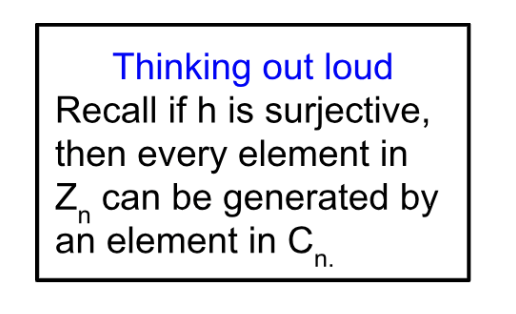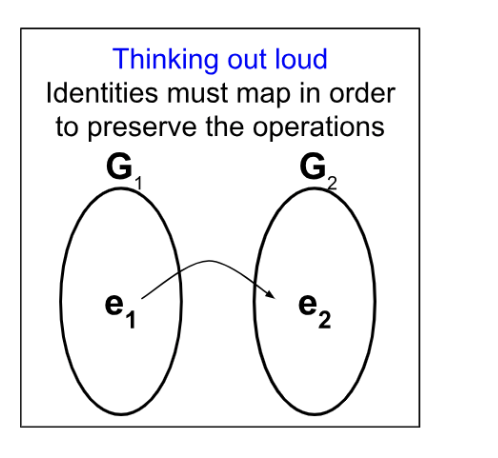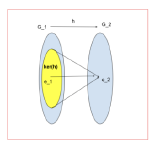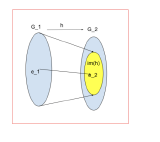4.3 : Homomorphisms
- Page ID
- 132495
Let \((G_1,\star_1)\), \((G_2, \star_2)\) be groups.
Then a function \(h:G_1 \rightarrow G_2\) s.t. \(h(g_1)=g_2, g_1 \in G_1 \text{and } g_2 \in G_2\) is called a homomorphism from the group \(G_1\) to the group \(G_2\) if \(h(g_1 \star_1g_1^{\shortmid})=h(g_1)\star_2 h(g_1^{\shortmid}), \;g_1,g_1^{\shortmid} \in G_1\).
Further, if \(h\) is a bijection and also a homomorphism, then \(h\) is called an isomorphism. In this case, we say \(G_1 \cong G_2\), which means that \(G_1\) is congruent to \(G_2\).
Let \(C_n=<a,a^n=e>\) be a cyclic group.
Define: \(h: C_n \rightarrow \mathbb{Z}_n \) by \(h(a^k)=k \pmod{n}\). Then
-
Is \(h\) a homomorphism?
-
Is \(h\) injective (1-1)?
-
Is \(h\) surjective (onto)?
If all three are true, then \(h\) is an isomorphism.
Proof:
We will show a finite cyclic group is always isomorphic to \((\mathbb{Z}_n, + \pmod{n})\).
Proof of Homomorphism:
Let \(g_1,g_2 \in C_n\).
We shall show that \(h(g_1\star_1 g_2)=h(g_1)\star_2h(g_2)\).
Consider \(g_1=a^{k_1}\) and \(g_2=a^{k_2}\).
Then \(h(g_1)=k_1 \pmod{n}\) and \(h(g_2)=k_2 \pmod{n}\).
\(g_1\star_1 g_2=a^{k_1} \star_1 a^{k_2}=a^{k_1+k_2}\).
Thus \(h(g_1\star_1g_2)=k_1+k_2 \pmod{n}\).
Now consider \(h(g_1)\star_2 h(g_2)=k_1 \pmod{n} +k_2 \pmod{n}\)
\(=k_1+k_2 \pmod{n}\).
Hence \(h(g_1\star_1 g_2)=h(g_1)\star_2h(g_2)\).
Hence \(h\) is a homomorphism.◻
Proof of Injection (1-1):
Let \(g_1, g_2 \in G\) s.t. \(h(g_1)=h(g_2)\).
Since \(g_1, g_2 \in C_n\), \(g_1=a^{k_1}\) and \(g_2=a^{k_2}, \; k_1,k_2 \in \mathbb{Z}\).
Now, \(h(g_1)=k_1 \pmod{n}=k_2 \pmod{n}=h(g_2)\).
Therefore, \(k_1=k_2 \in \mathbb{Z}_n\).
Hence \(h\) is injective (1-1).◻
Proof of Surjective (onto):
Let \(k \in \mathbb{Z}_n\).
Since \(a^k \in C_n\) by definition \(h(a^k)=k \pmod{n}\).
Hence \(h\) is surjective.◻
Since a finite cyclic group is homomorphic, injective and surjective to \((\mathbb{Z}_n, + \pmod{n})\), it is isomorphic to \((\mathbb{Z}_n, + \pmod{n})\). ◻
Define \( h: (\mathbb{Z}, +) \to ( \mathbb{Z}_n, \cdot (mod n) \) defined by
\( h(k)= a^k, \) where \( \mathbb{Z}_n = <a>, k \in \mathbb{Z}. \) Then
For \( k, m \in \mathbb{Z}, h(k+m)= a^{k+m}= a^k a^m= h(k)h(m). \) Thus \(h\) is a homomorphism.
Notice that
|
\( 0 \) \( \pm n \) \( \pm 2n \) \( \pm 3n \) . . . . |
\( 1 \) \( 1 \pm n \) \( 1 \pm 2n \) \( 1 \pm 3n \) . . . . |
\( \cdots\) |
\( \cdots\) |
\( n-1 \) \(n-1 \pm n \) \( n-1 \pm 2n \) \( n-1 \pm 3n \) . . . . |
\(\mathbb{Z} \) |
|
\( \downarrow\) |
\( \downarrow\) |
\( \downarrow\) |
\( \downarrow\) |
\( \downarrow\) |
|
|
\( a^0\) |
\(a^1\) |
\(a^{n-1}\) |
\(\mathbb{Z}_n \) |
Hence \( h \) is onto but not one to one.
Properties of homomorphisms:
Let \(h: G_1 \rightarrow G_2\) be a homomorphism. Then:
-
\( h(e_1)=e_2 \), where \( e_1, e_2 \) are identities of \( G_1, G_2 \) respectively.

-
\(h(g_1^{-1})=h(g_1)^{-1}, g_1 \in G_1\).
-
\(h(g^n)=h(g)^n\), \( n \in \mathbb{Z} \)
Proof:
-
Since \( e_1 \) is the identity of \( G_1 \), \( e_1 e_1=e_1. \)
Since \( h \) is a homomorphism, \( h(e_1e_1)= h(e_1) h(e_1)=h(e_1)=e_2 h(e_1). \)
By cancellation law, \(e_2 = h(e_1). \)
-
Let \( g_1 \in G_1.\) Then \( g_1g_1^{-1}=e_1.\)
Since \( h \) is a homomorphism, \( h(g_1g_1^{-1})=h(g_1) h(g_1^{-1}) = h(e_1)=e_2.\)
Hence \( (h(g_1))^{-1} = h(g_1^{-1}). \)
-
Use induction on \( \mathbb{Z}_+ \).
Let \( h: G_1 \to G_2\) be a homomorphism. Then \( ker(h) \leq G_1 \) and \( im(h) \leq G_2. \) Also, \(\ker (h) \) is a normal subgroup of \(G _1\).
- Proof:
-
Let \( h: G_1 \to G_2\) be a homomorphism.
Since \( h(e_1)=e_2, e_1 \in ker(h).\) Let \( g_1, g_1^{'} \in ker(h).\) Then \( h(g_1)=e_2 \) and \( h( g_1^{'}) =e_2. \)
Similarly, we can show that \( im(h) \leq G_2. \)
We shall show that \( g_1^{-1} g_1^{'} \in ker(h).\)
Consider \( h(g_1^{-1} g_1^{'})= h(g_1^{-1})h( g_1^{'}) = h(g_1)^{-1} h( g_1^{'}) = e_2^{-1} e_2=e_2. \) Hence \( g_1^{-1} g_1^{'} \in ker(h).\) Thus \( ker(h) \leq G_1. \)
We shall show that \(\ker (h) \) is a normal subgroup of \(G_1 \).
Let \(h \in \ker(h) \) s.t. \(h(h)=e_H \).
We will show \(ghg^{-1}\in \ker(h), \forall \; g \in G_1 \).
Consider \(h(ghg^{-1})=h(g) h(h) h(g^{-1}) \)
\(= h(g) h(h) (h(g))^{-1} \)
\(=h(g) e_H (h(g))^{-1} \)
\(=h(g) (h(g))^{-1} \)
\(=e_H \).
So \(\ker(h) \) is a normal subgroup of \(G_1 \).



